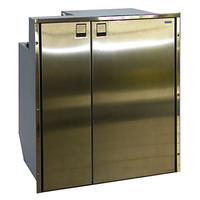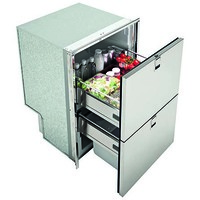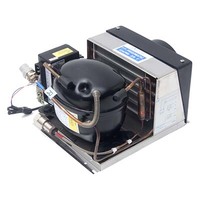Boat and Caravan Refrigeration
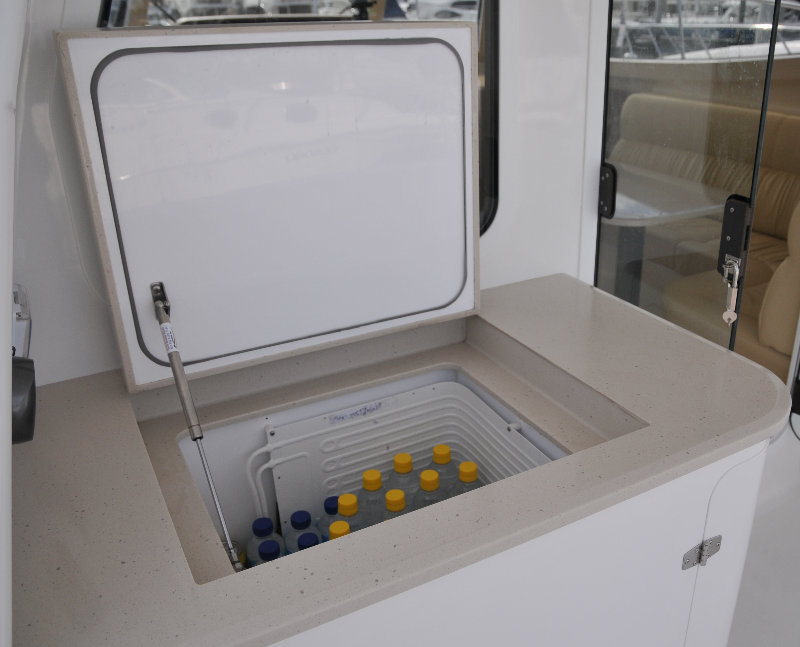
Outback Marine is the Australian distributor for Veco Frigoboat - an Italian manufacturer of marine refrigeration systems and equipment for over 40 years. Using familiar Danfoss DC compressors, Veco has developed condenser sets that are efficient to run and are built to last. With the choice of air, water or keel cooled condenser sets and industry-leading features such as pre-charged components with self-sealing couplings it has never been easier to custom build efficient and reliable refrigeration systems.
Dependence on refrigeration is no less on the water than it is at home. On a 24 hour basis, refrigeration systems will consume more power than any other essential vessel service. An efficient refrigeration system means that less power needs to be generated. Engine battery charging time can be significantly reduced or even replaced with a solar charging system.
Design
15 years ago Outback Marine released the Refrigeration Systems eBook. This eBook was and still is, a valuable resource for anyone looking to design or understand refrigeration systems based on Danfoss compressors. It is still available for download here: REFRIGERATION SYSTEMS EBOOK.
Troubleshooting
If you are having issues with any Danfoss based DC refrigeration system, this REFRIGERATION TROUBLESHOOTING page from Coastal Climate Control in North America is an excellent resource.
12/24 volt DC fridge and freezer cabinets with front opening door.
- Mounts into cutout in face of galley/kitchen cabinets or bulkheads
- Requires ventilation at back of cabinet
- Fridge, freezer and combination units available
Drawer style 12/24 volt DC fridge and freezer cabinets.
- Mounts into cutout in face of galley/kitchen cabinets or bulkheads
- Drawer storage secures contents
- Fridge, freezer and combination units available
Components to build a custom 12/24 volt DC refrigeration system.
- Choice of 12/24 volt DC air, water or keel condenser sets
- Evaporator plate range for small to large insulated boxes
- Thermostat and Danfoss compressor parts
How to Build a Boat Refrigeration System
Lots of cold drinks; plenty of fresh food; sufficient ice for cocktails; ample frozen meat, fish and vegetable storage. Providing all of this does not mean that you have to run a generator for hours and hours each day. Our Frigomatic systems are designed from the ground up for marine applications. The right system will keep icecream hard in the freezer; will chill a slab of beer to drinking temperature in a matter of hours and will use a minimum amount of energy.
Outback Marine can engineer a system that allows you to enjoy all of these benefits on solar power alone or just a short period of generator set/engine run time each day. The cost and weight of such a system will be much less than common eutectic type systems.
A good refrigeration and freezer system becomes a priority for remote area living. This application brief covers the basics of an optimal refrigeration system design. The number and size of boxes can be varied to meet individual needs. Operational objectives are similar to household refrigeration except that unique aspects of a mobile installation accentuate certain requirements.
- refrigerator and freezer product need to be kept at required temperatures
- modular service capability by way of quick connect/disconnect fittings
- operation independent of an engine driven power source
- fast temperature pull-down for newly stored product
- versatility for varying storage requirements
- low maintenance and high reliability
- minimal weight and quiet operation
- high energy efficiency
Refrigerator Box Insulation
The amount of energy required to run a refrigeration system is related to the amount of energy lost through the box insulation and the coefficient of performance (COP) of the refrigeration plant. Additional factors include the energy that is required to bring stored product down to temperature and the energy lost through exchange of air that occurs with door openings. For the sake of practical design, these losses are small and are not considered in the following discussion on insulation.
Four factors determine the energy loss through the enclosure:
- Temperature differential: the difference between the inside box temperature and outside ambient temperature.
- Insulation surface area: larger boxes (with more surface area) require more energy
- Insulation thickness: thicker insulation requires less energy
- Insulation factor: higher performance insulation requires less energy
Energy loss is expressed in BTU’s (British Thermal Units) per hour. The charts below show the heat loss in BTU’s per hour for refrigeration and freezer enclosures of differing surface areas and insulation thickness - assuming quality Urethane or Styrofoam insulation (.17 K Factor). First, calculate the outside surface area of the enclosure. For example, an enclosure measuring 700mm x 700mm x 700mm has an outside surface area of 2.5 square metres.
Reference the charts below to find the heat loss (BTU’s per Hour) for the insulation thickness used. It is evident by the charts that insulation thickness has a dramatic effect on heat loss and subsequent energy requirements. We recommend 100 mm of insulation for refrigeration and 150 mm for a freezer. In our example above with recommended insulation and a surface area of 2.5 Sq M., we would lose about 80 BTU/Hr for the refrigerator and about 70 BTU/hr for the freezer.
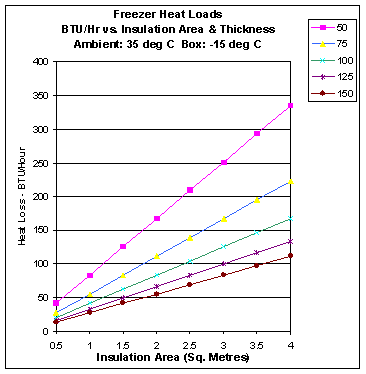 |
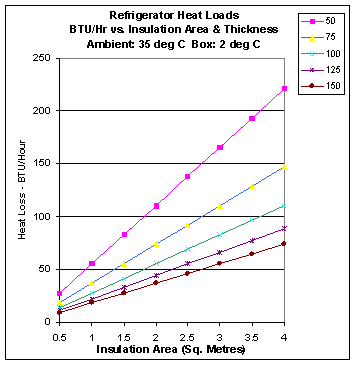 |
| Freezer Heat Loads | Refrigerator Heat Loads |
Compressor Coefficient of Performance
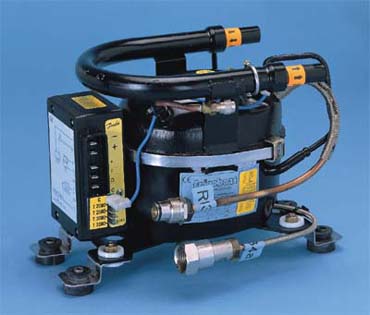 The COP influences the amount of BTU’s per hour that the refrigeration plant can transfer for a given amount of energy. It is a measure of system efficiency. Factors influencing the COP include:
The COP influences the amount of BTU’s per hour that the refrigeration plant can transfer for a given amount of energy. It is a measure of system efficiency. Factors influencing the COP include:
- Evaporation temperature: lower plate temperatures decrease efficiency
- Head pressure: higher pressures require more power
- Compressor characteristics: higher compressor speeds decrease efficiency
Freezers require lower plate temperatures than refrigerators. In both cases however, selecting a larger evaporator plate will save energy as the plate temperature will be higher for any given box temperature. Spacing the evaporator away from the cabinet wall will effectively increase surface area as well. The head pressure (or work load of the compressor) depends on the system load and the efficiency of the condenser. As the head pressure is directly proportional to condensation temperature, good condenser design and installation practices will improve both efficiency and performance.
Most DC systems used in mobile applications use Danfoss BD35 or BD50 type compressors. The compressor speed needs to be high enough to meet the system load but not to high as to lose efficiency. The speed should be matched to system requirements.
System Tradeoffs
It is important to realise that compromising insulation thickness (maybe to gain extra internal volume), will come at the cost of more energy to run the system and will have an impact on actual refrigeration performance. Attention should be given to equipment capacity vs. box heat load: type and capacity of condensation system, evaporator plate sizing and technology, compressor size and box temperature. A system analysis should always include the cost of energy generation to support the system in addition to the cost of refrigeration equipment. More often than not, the perceived low cost system is actually more expensive when taking the overall system into account.
All of our refrigeration systems feature quick connect and disconnect couplings - in most cases, you do not need to hire a refrigeration mechanic. The systems are powered from your 12 volt or 24 volt battery supply.
We can assist you in your own installation or if you prefer we can manage the whole job.
There are five key components to build a refrigeration system:
- Compressor - to compress the refrigerant gas (supplying the energy to pump the heat)
- Condenser - to condense the gas into a liquid (rejecting heat to surroundings)
- Evaporator Plate - where the refrigerant liquid changes state to a gas (absorbing heat from surroundings)
- Thermostat - switches the compressor on and off to maintain a relatively constant temperature
- Insulation - controls the rate of heat loss from the refrigeration enclosure
Many approaches have been taken to mobile refrigeration systems over the years. The biggest breakthrough was the advent of the Danfoss DC powered compressor in conjunction with efficient 12/24 volt DC energy systems.
It was once required to use an engine driven compressor that would store energy in a holding plate type evaporator to chill the refrigerated enclosure. The compressor would be either belt driven directly from an engine or powered by an AC motor that required a generator set. It would need to be run for around two hours per day—once in the morning and again in the evening. They are relatively high in cost, heavy and require a person to start an engine at the time dictated by the system.
The Danfoss system runs directly from stored energy in the battery bank. The compressor will run when it needs to. They use a light weight evaporator plate that has little impact on enclosure volume. A system that is properly manufactured and configured provides excellent service at significantly less cost compared to a holding plate system.
The selection of the right Danfoss system depends on box heat load and the preferred type of condensation method.

